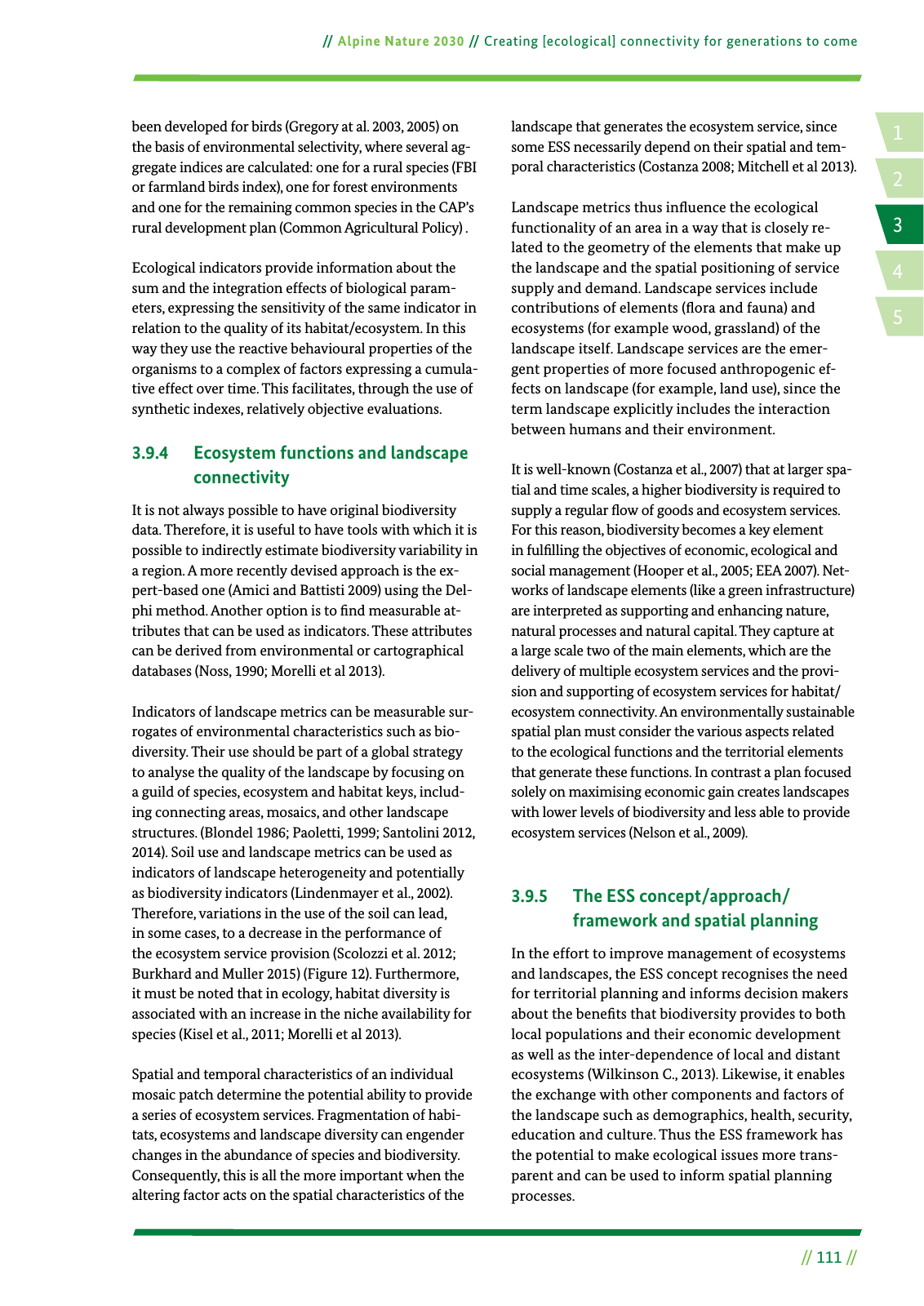14 2 5 3 Alpine Nature 2030 Creating ecological connectivity for generations to come 111 been developed for birds Gregory at al 2003 2005 on the basis of environmental selectivity where several ag gregate indices are calculated one for a rural species FBI or farmland birds index one for forest environments and one for the remaining common species in the CAP s rural development plan Common Agricultural Policy Ecological indicators provide information about the sum and the integration effects of biological param eters expressing the sensitivity of the same indicator in relation to the quality of its habitat ecosystem In this way they use the reactive behavioural properties of the organisms to a complex of factors expressing a cumula tive effect over time This facilitates through the use of synthetic indexes relatively objective evaluations 3 9 4 Ecosystem functions and landscape connectivity It is not always possible to have original biodiversity data Therefore it is useful to have tools with which it is possible to indirectly estimate biodiversity variability in a region A more recently devised approach is the ex pert based one Amici and Battisti 2009 using the Del phi method Another option is to nd measurable at tributes that can be used as indicators These attributes can be derived from environmental or cartographical databases Noss 1990 Morelli et al 2013 Indicators of landscape metrics can be measurable sur rogates of environmental characteristics such as bio diversity Their use should be part of a global strategy to analyse the quality of the landscape by focusing on a guild of species ecosystem and habitat keys includ ing connecting areas mosaics and other landscape structures Blondel 1986 Paoletti 1999 Santolini 2012 2014 Soil use and landscape metrics can be used as indicators of landscape heterogeneity and potentially as biodiversity indicators Lindenmayer et al 2002 Therefore variations in the use of the soil can lead in some cases to a decrease in the performance of the ecosystem service provision Scolozzi et al 2012 Burkhard and Muller 2015 Figure 12 Furthermore it must be noted that in ecology habitat diversity is associated with an increase in the niche availability for species Kisel et al 2011 Morelli et al 2013 Spatial and temporal characteristics of an individual mosaic patch determine the potential ability to provide a series of ecosystem services Fragmentation of habi tats ecosystems and landscape diversity can engender changes in the abundance of species and biodiversity Consequently this is all the more important when the altering factor acts on the spatial characteristics of the landscape that generates the ecosystem service since some ESS necessarily depend on their spatial and tem poral characteristics Costanza 2008 Mitchell et al 2013 Landscape metrics thus in uence the ecological functionality of an area in a way that is closely re lated to the geometry of the elements that make up the landscape and the spatial positioning of service supply and demand Landscape services include contributions of elements ora and fauna and ecosystems for example wood grassland of the landscape itself Landscape services are the emer gent properties of more focused anthropogenic ef fects on landscape for example land use since the term landscape explicitly includes the interaction between humans and their environment It is well known Costanza et al 2007 that at larger spa tial and time scales a higher biodiversity is required to supply a regular ow of goods and ecosystem services For this reason biodiversity becomes a key element in ful lling the objectives of economic ecological and social management Hooper et al 2005 EEA 2007 Net works of landscape elements like a green infrastructure are interpreted as supporting and enhancing nature natural processes and natural capital They capture at a large scale two of the main elements which are the delivery of multiple ecosystem services and the provi sion and supporting of ecosystem services for habitat ecosystem connectivity An environmentally sustainable spatial plan must consider the various aspects related to the ecological functions and the territorial elements that generate these functions In contrast a plan focused solely on maximising economic gain creates landscapes with lower levels of biodiversity and less able to provide ecosystem services Nelson et al 2009 3 9 5 The ESS concept approach framework and spatial planning In the effort to improve management of ecosystems and landscapes the ESS concept recognises the need for territorial planning and informs decision makers about the bene ts that biodiversity provides to both local populations and their economic development as well as the inter dependence of local and distant ecosystems Wilkinson C 2013 Likewise it enables the exchange with other components and factors of the landscape such as demographics health security education and culture Thus the ESS framework has the potential to make ecological issues more trans parent and can be used to inform spatial planning processes

Hinweis: Dies ist eine maschinenlesbare No-Flash Ansicht.
Klicken Sie hier um zur Online-Version zu gelangen.
Klicken Sie hier um zur Online-Version zu gelangen.